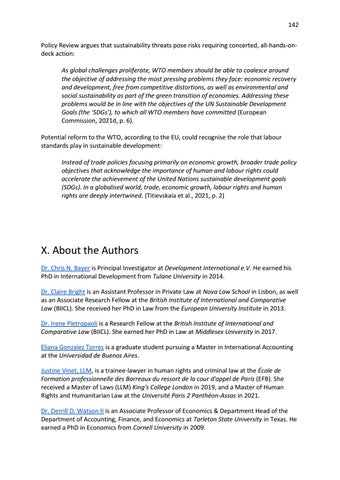142 Policy Review argues that sustainability threats pose risks requiring concerted, all-hands-ondeck action: As global challenges proliferate, WTO members should be able to coalesce around the objective of addressing the most pressing problems they face: economic recovery and development, free from competitive distortions, as well as environmental and social sustainability as part of the green transition of economies. Addressing these problems would be in line with the objectives of the UN Sustainable Development Goals (the ‘SDGs’), to which all WTO members have committed (European Commission, 2021d, p. 6). Potential reform to the WTO, according to the EU, could recognise the role that labour standards play in sustainable development: Instead of trade policies focusing primarily on economic growth, broader trade policy objectives that acknowledge the importance of human and labour rights could accelerate the achievement of the United Nations sustainable development goals (SDGs). In a globalised world, trade, economic growth, labour rights and human rights are deeply intertwined. (Titievskaia et al., 2021, p. 2)
X. About the Authors Dr. Chris N. Bayer is Principal Investigator at Development International e.V. He earned his PhD in International Development from Tulane University in 2014. Dr. Claire Bright is an Assistant Professor in Private Law at Nova Law School in Lisbon, as well as an Associate Research Fellow at the British Institute of International and Comparative Law (BIICL). She received her PhD in Law from the European University Institute in 2013. Dr. Irene Pietropaoli is a Research Fellow at the British Institute of International and Comparative Law (BIICL). She earned her PhD in Law at Middlesex University in 2017. Eliana Gonzalez Torres is a graduate student pursuing a Master in International Accounting at the Universidad de Buenos Aires. Justine Vinet, LLM, is a trainee-lawyer in human rights and criminal law at the École de Formation professionnelle des Barreaux du ressort de la cour d'appel de Paris (EFB). She received a Master of Laws (LLM) King's College London in 2019, and a Master of Human Rights and Humanitarian Law at the Université Paris 2 Panthéon-Assas in 2021. Dr. Derrill D. Watson II is an Associate Professor of Economics & Department Head of the Department of Accounting, Finance, and Economics at Tarleton State University in Texas. He earned a PhD in Economics from Cornell University in 2009.













